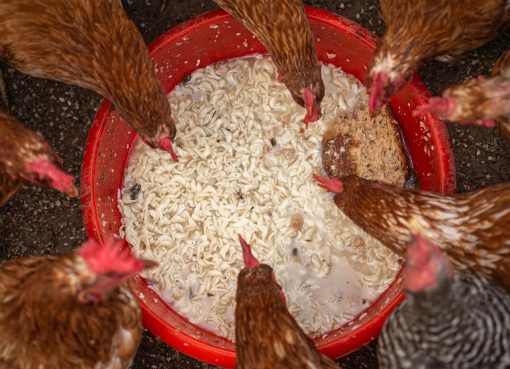Subhalakshmi Gogoi
4th year, BVSc and AH
College of Veterinary Science, AAU
Khanapara, Guwahati
ABSTRACT
There has been a rapid development in the poultry sector since the last decade. Backyard rearing of poultry was most prominent in India, although poultry industry culture is more in trend now. Every household used to traditionally rear local breeds of chicken as they provide eggs and meat which are the main sources of protein for the human population. The proportion of hybrid poultry population gradually started increasing overtaking the proportion of indigenous breeds in a few years. This led to an evolutionary advancement in the poultry industry of India. People started to realize the huge potential of the poultry sector and started rearing them in the shape of small-scale industries. The Green Revolution had also marked a tremendous impact. Crop production is not only the sole sector which needs progress but to maintain a balanced diet, the livestock sector should also be taken into consideration for economic and healthy development of a nation. A balanced diet must contain all the essential nutrients including fat, carbohydrates, proteins, minerals, vitamins and water. To maintain this diet, people need to consume proportionate amounts of cereals, meat, fish, eggs, milk, etc. Hence, increased supply of these items can only be met by increasing production of livestock and its related products.
Keywords: poultry, hybrid, industry, rearing, economy, protein, livestock, balanced diet, eggs, meat
Introduction: A Brief History of Poultry Rearing in India
Only local breeds of poultry were reared till 1961, when the proportion of hybrid population rose upto 2%. Within the next few decades, tremendous increase in hybrid breeds was observed and these breeds were dominating the market sidelining the indigenous breeds. The earliest reared birds were the jungle fowls raised by the hill tribes. They were not looked after properly and basically fed on whatever was available on the ground. There was no proper management and housing system for them. The Aseel was the first Indian breed which was taken into consideration for cock fighting.
The system of scientific poultry farming was first started by the Christian missionaries towards the beginning of 20th century in India. The launching of the first scientific poultry farm took it’s form in Etah, U.P. in 1912. In the year 1957, a five-year plan to initiate development in the poultry sector was sanctioned by the Government of India. The commencement of different regional centers set up by an All India Poultry Development Project took place in Delhi, Shimla, Mumbai, Bangalore and Bhubaneshwar. Their main motive was to promote extensive poultry farming.
The turning point in the poultry sector appeared between the second and the fourth Five-Year Plans. During this period, the Intensive Poultry Development Programme was introduced considering the needs of the local farmers. A cosmic change took place in the poultry industry during the middle and the late seventies with the establishment of the Central Avian Research Institute in Izatnagar, Bareily, U.P. in 1979. Production in poultry had risen tremendously since then.
Poultry Farming: A Whooping Profitable Enterprise in Trend
Many entrepreneurs are captivated by the huge profits being made in this sector. Industrialization of poultry farming has helped in strengthening the nation’s economy to a great extent by giving good returns be it in terms of money, protein sources for the people or employment opportunities basically for the rural youth. There are numerous factors which attract entrepreneurs towards this source of income. Some of these factors include:
- Can be started with a small amount of capital: Small scale farmers can start this business with a small investment as compared to businesses related to other livestock sectors. After completion of the laying stage of the layers, e., after 18 months, can be sold as bird meat. Broilers, on the other hand, when reach their market age, i.e., 6 weeks, can be directly sold to consumers or handed over to the wholesalers. The minimum investment required for rearing approximately 100 layers is around Rs. 10,000.00 which is a considerable amount in comparison to other sectors.
- Expeditious profits / returns: Investment in this sector does not require huge interval for profits to be generated. The laying age of chicken is around 6-8 months, and the marketing age of broilers is around 6-8 weeks. Therefore, it can be concluded that a very short interval of time is required to make phenomenal profits.
- Small space – area requirement: In backyard rearing, minimal space is required as they can be reared in the backyard of homes. In the deep litter system, 1 sq. ft. is required for each bird and much lesser is required in case of cage system.
- Feed and water requirement is minimal: Wastes from homes can be given as feed to the birds along with grains. Around 2 kg of feed is sufficient for producing 1 kg of broiler meat e., they have high feed conversion efficiency.
- Water requirement: The water requirement is also very small. Only about 1 litre of water is enough for cleaning, and drinking purposes of 5 birds in a day.
- Continuous and equilibrate farm income: Instead of being a seasonal source of income, it serves as a good income source throughout the year. Huge expenditure and labour force are not required in this business sector.
- As in other income sectors, there may be a rise or fall in the profit values. So, a substantial source of income serves as a high ground for this industry.
- Rich source of fertilizer: Poultry manure acts as a rich source of nitrogen, potassium and phosphorus content. Therefore, their droppings enrich the soil. They are also catchers of pests, worms and insects infesting the crop fields.
- Chicken meat and eggs are highly nutritious: To build a healthier nation, its people must have access to adequate amounts of protein and calories. Eggs serve as a budget-friendly and highly nutritious source of food for the people.
- Poultry meat is also a copious reservoir of protein and essential amino acids. It is very low in fat and cholesterol level.
The Evolutionary Phase of Poultry Farming in India:
The evolutionary phase of poultry farming in India started during the early 1960s. The Poultry Development Index was constructed to estimate the growth in major poultry producing states. The Northeastern states were found to be at the topmost with Assam in the first rank in the order. The production of poultry products including eggs, broilers and poultry meat increased enormously from 1961 to 1996 and is ever increasing since then at the speed of light. Statistical data shows an 8% growth per annum in poultry. The mean productivity level of Desi (local) breeds had also shown a massive progress for the period 1987-1994 in India.
Poultry Farming: A Ground for Countless Job Opportunities
Poultry farming sector not only provides innumerable job opportunities to the men but also to the women, young and older group of people, since no extensive amount of labour is required. Poultry farms are easy to manage as the birds are docile. It also serves as an indirect means of employment for the transporters and distributors related to this sector. According to recent data analysis, about 30 million farmers in India are still engaged in backyard poultry rearing system, although the large-scale commercial poultry farms have taken over the scenario of majority of poultry production in India. About 80% egg production is being contributed by the commercial farms.
Conclusion:
Poultry farming is an ever-growing pool of feasible business activities. It acts as a sustainable field of income mainly for the young rural entrepreneurs. India stands at the 3rd rank in terms of chicken egg production and at the 7th rank in chicken meat production. Technological advancements in the poultry sector have brought about extraordinary revolution of the entire anatomy of the poultry industry in India. Integration of both wholesale and retail markets also plays a significant role in the commodity market. Positive price hike has been observed in the market value attracting many sellers and entrepreneurs. Allocation of funds by the government serves as an important factor in industrialization of this growing market. But only a few states have been able to achieve the surreal production goals.
“The sector of poultry farming can serve as a vast field of countless job opportunities for the upcoming youth only if supported by the government. It can lead to evolution of the whole economy of a nation.”
References:
– SciELO, Vetrivel, S.C. and Chandrakumarmangalam, S. (2013). The role of poultry industry in Indian economy. Braz. J. Poult. Sci. 15 (4). https://doi.org/10.1590/S1516-635X2013000400001
Ryan Tseng (2022). A Look into India’s Poultry Industry, FFAC, New Roots Institute. A Look Into India’s Poultry Industry | New Roots Institute
Chandi, K.T. Poultry farming in India, Booklet No. 49, Animal Husbandry: Poultry: PLS-1. Poultry-Farming-in-India-049.doc (live.com)



